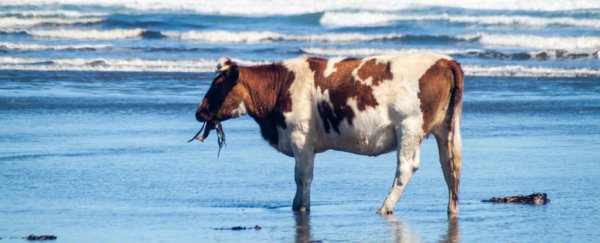If we add dried seaweed to 2 percent of sheep and cattle feed, we could cut methane emissions by more than 70 percent, scientists have found.
With livestock responsible for 44 percent of all human-caused methane - a gas that has 36 times the global warming potential of CO2 - this could cut a huge chunk of the 3.1 gigatonnes these animals release into the atmosphere each year in burps and farts.
To put that 3.1 gigatonnes of methane into perspective, the entire European Union releases just over that amount of CO2 each year.
And if we cut that 3.1 gigatonnes by 70 percent by adding seaweed to livestock feed, we'd be clearing 2.17 gigatonnes of methane released into the atmosphere by livestock every year.
That's almost the amount of CO2 the entire country of India emits every year.
If you consider that methane has far higher global warming potential than CO2, it makes this find even more exciting.
For a little background on just how damaging methane emissions from livestock are, scientists estimate the Global Warming Potential (GWP) of every emission based on two key factors: their ability to absorb energy, and how long they stay in the atmosphere.
CO2 has a GWP of 1, and scientists have averaged this out across its lifespan in Earth's climate system, which lasts for thousands of years.
Atmospheric methane, on the other hand, has a GWP of 28-36 over its first 100 years in Earth's climate system. That means methane's lifetime in the atmosphere is much shorter than carbon dioxide's, but it's up to 36 times more efficient at trapping radiation.
In fact, a recent report from the Intergovernmental Panel on Climate Change found that during its first 20 years in the atmosphere, methane has a GWP of 86. That means in the short-term, methane has the capacity to warm the planet by 86 times as much as CO2.
It's often said that methane emissions from livestock come from their farts, but their farts aren't actually as big of a problem as you might think. Their burps actually make up 90 percent of their methane emissions, and their farts are responsible for the remaining 10 percent.
So how do we get these animals to burp out less methane?
While researchers have been looking into seaweed's potential for curbing livestock emissions for a couple of years now, the most exciting result came out in late 2015, when a team from Australia found that a particular type of local seaweed, called Asparagopsis taxiformis, reduces methane production by more than 99 percent in the lab.
That's an impressive figure, but doesn't really mean much until it's applied to real animals, right? Well, researchers from James Cook University in Queensland did just that, and found that they could cut a significant amount of methane emissions - and with a very small amount of seaweed.
"We have results already with whole sheep; we know that if Asparagopsis is fed to sheep at 2 percent of their diet, they produce between 50 and 70 percent less methane over a 72-day period continuously, so there is already a well-established precedent," one of the team, Rocky De Nys, told ABC News.
As agriculture researcher Michael Battaglia from Australia's CSIRO explains over at The Conversation, the reason this particular type of seaweed is so effective is because it produces a compound called bromoform (CHBr3), which blocks methane production by reacting with vitamin B12 at the last step.
"This disrupts the enzymes used by gut microbes that produce methane gas as waste during digestion," he says.
While each individual sheep and cow wouldn't need much seaweed on its own, when you consider that there are 98.4 million cattle in the US alone, things start to add up.
Battaglia estimates that to farm enough seaweed to cover Australia's livestock, we'd need to establish roughly 6,000 hectares of seaweed farms, which isn't going to be easy to find.
But if the world gets desperate enough - and considering the level of greenhouse gases in our atmosphere right now, we just might - this could be our saving grace.
According to De Nys, seaweed trials with live animals will be ongoing in Queensland farms until mid-next year.
We can't wait to see the results.
